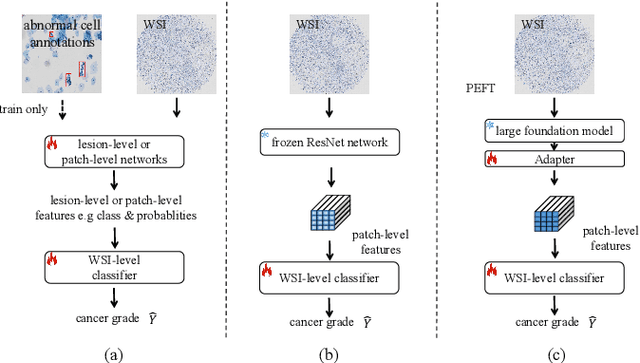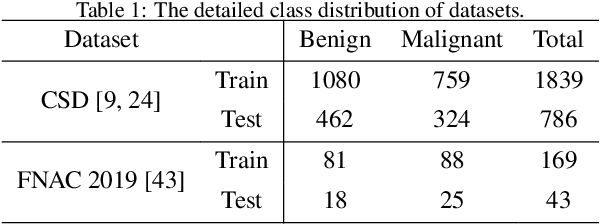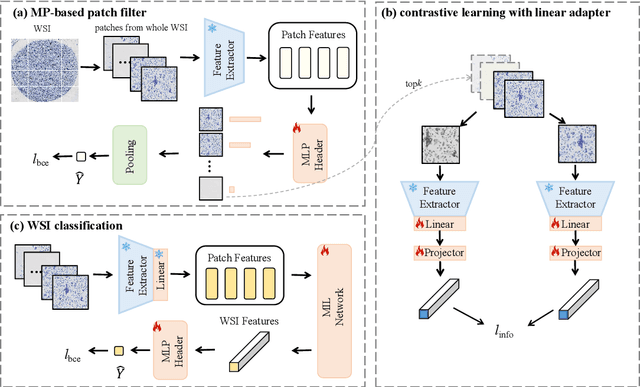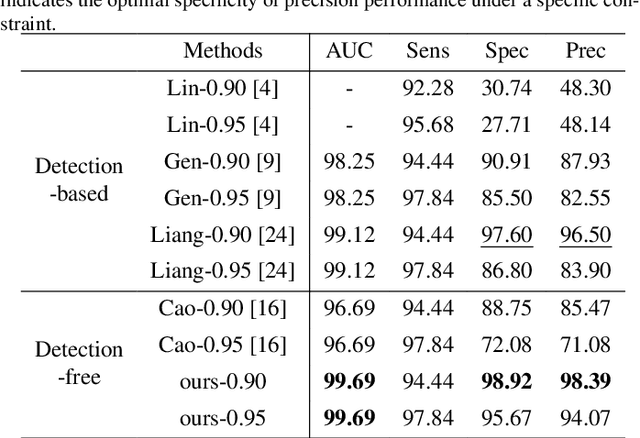Jialong Huang
An efficient framework based on large foundation model for cervical cytopathology whole slide image screening
Jul 16, 2024



Abstract:Current cervical cytopathology whole slide image (WSI) screening primarily relies on detection-based approaches, which are limited in performance due to the expense and time-consuming annotation process. Multiple Instance Learning (MIL), a weakly supervised approach that relies solely on bag-level labels, can effectively alleviate these challenges. Nonetheless, MIL commonly employs frozen pretrained models or self-supervised learning for feature extraction, which suffers from low efficacy or inefficiency. In this paper, we propose an efficient framework for cervical cytopathology WSI classification using only WSI-level labels through unsupervised and weakly supervised learning. Given the sparse and dispersed nature of abnormal cells within cytopathological WSIs, we propose a strategy that leverages the pretrained foundation model to filter the top$k$ high-risk patches. Subsequently, we suggest parameter-efficient fine-tuning (PEFT) of a large foundation model using contrastive learning on the filtered patches to enhance its representation ability for task-specific signals. By training only the added linear adapters, we enhance the learning of patch-level features with substantially reduced time and memory consumption. Experiments conducted on the CSD and FNAC 2019 datasets demonstrate that the proposed method enhances the performance of various MIL methods and achieves state-of-the-art (SOTA) performance. The code and trained models are publicly available at https://github.com/CVIU-CSU/TCT-InfoNCE.
Few-shot fault diagnosis based on multi-scale graph convolution filtering for industry
May 30, 2024Abstract:Industrial equipment fault diagnosis often encounter challenges such as the scarcity of fault data, complex operating conditions, and varied types of failures. Signal analysis, data statistical learning, and conventional deep learning techniques face constraints under these conditions due to their substantial data requirements and the necessity for transfer learning to accommodate new failure modes. To effectively leverage information and extract the intrinsic characteristics of faults across different domains under limited sample conditions, this paper introduces a fault diagnosis approach employing Multi-Scale Graph Convolution Filtering (MSGCF). MSGCF enhances the traditional Graph Neural Network (GNN) framework by integrating both local and global information fusion modules within the graph convolution filter block. This advancement effectively mitigates the over-smoothing issue associated with excessive layering of graph convolutional layers while preserving a broad receptive field. It also reduces the risk of overfitting in few-shot diagnosis, thereby augmenting the model's representational capacity. Experiments on the University of Paderborn bearing dataset (PU) demonstrate that the MSGCF method proposed herein surpasses alternative approaches in accuracy, thereby offering valuable insights for industrial fault diagnosis in few-shot learning scenarios.
A novel fault localization with data refinement for hydroelectric units
May 30, 2024Abstract:Due to the scarcity of fault samples and the complexity of non-linear and non-smooth characteristics data in hydroelectric units, most of the traditional hydroelectric unit fault localization methods are difficult to carry out accurate localization. To address these problems, a sparse autoencoder (SAE)-generative adversarial network (GAN)-wavelet noise reduction (WNR)- manifold-boosted deep learning (SG-WMBDL) based fault localization method for hydroelectric units is proposed. To overcome the data scarcity, a SAE is embedded into the GAN to generate more high-quality samples in the data generation module. Considering the signals involving non-linear and non-smooth characteristics, the improved WNR which combining both soft and hard thresholding and local linear embedding (LLE) are utilized to the data preprocessing module in order to reduce the noise and effectively capture the local features. In addition, to seek higher performance, the novel Adaptive Boost (AdaBoost) combined with multi deep learning is proposed to achieve accurate fault localization. The experimental results show that the SG-WMBDL can locate faults for hydroelectric units under a small number of fault samples with non-linear and non-smooth characteristics on higher precision and accuracy compared to other frontier methods, which verifies the effectiveness and practicality of the proposed method.
 Add to Chrome
Add to Chrome Add to Firefox
Add to Firefox Add to Edge
Add to Edge